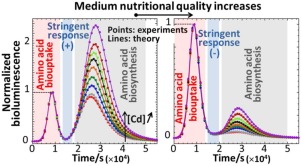Sensors and Actuators B: Chemical ( IF 8.4 ) Pub Date : 2020-01-20 , DOI: 10.1016/j.snb.2020.127751 Jérôme F.L. Duval , Christophe Pagnout

|
Whole cell luminescent bacterial sensors are used to monitor the bioavailability and toxicity of metals in aquatic media. Any rationale of the time response of such metal-detecting biosensors necessarily asks for the so-far missing measurement and modeling of the impacts of medium nutritional quality on lux-reporter expression and bioluminescence production. In this work, improvement of nutritional conditions in bioluminescence assays by increasing amino acid concentration is shown to generate a transition from metal concentration-dependent monomodal to bimodal bell-shaped signal. The long-term component of the latter features a stringence-mediated adaptation of the cells to deficiency in nutrients supply from the medium. The demonstration is based on the analysis of the ∼17 h response of bioluminescent Escherichia coli engineered with luxCDABE reporter genes placed under the transcriptional control of a cadmium (0-22 nM bulk solution concentration) inductible-PzntA promoter or of the ribosomal RNA rrnB P1 promoter repressed by (p)ppGpp alarmones synthesized by cells in nutritional stress. The time-dependence of normalized PzntA-luxCDABE biosensor signal is successfully reproduced by our recent theory elaborated for the kinetics of bioluminescence emission by metal-responsive biosensors. The formalism allows assessment of luciferase half-life and of the time variations of cells photoactivity with medium composition. The theoretically-determined long-term kinetics of cell photoactivation is remarkably supported by independent measurements on the rrnB P1-luxCDABE bioreporter. Results clarify the origin of the mismatch between maxima in photoactive biomass and in bioluminescence over time, and they offer practical options for addressing contaminant toxicity via cell photoactivity derived from deconvolution of normalized biosensor response.
中文翻译:

金属检测发光全细胞生物报告子的双峰严格介导的反应:实验证据和定量理论
全细胞发光细菌传感器用于监测金属在水生介质中的生物利用度和毒性。这种金属检测生物传感器的时间响应的任何基本原理都必然要求迄今为止缺少中等营养质量对勒克斯报道基因表达和生物发光产生的影响的测量和建模。在这项工作中,通过增加氨基酸浓度改善了生物发光测定中的营养条件,显示出从依赖金属浓度的单峰转变为双峰钟形信号。后者的长期成分的特征是细胞通过严格介导的适应性来适应培养基中营养供应的不足。该演示是基于分析〜的生物发光17小时响应大肠杆菌具有工程luxCDABE镉(0-22 nM的本体溶液浓度)的转录控制下放置报告基因inductible-P zntA启动子或核糖体RNA的子rrnB P1启动子在营养胁迫下被细胞合成的(p)ppGpp警报抑制。标准化P zntA-luxCDABE的时间依赖性生物传感器信号已成功地通过我们最近针对金属响应生物传感器的生物发光发射动力学详细阐述的理论进行了复制。形式主义可以评估荧光素酶的半衰期以及培养基组成对细胞光活性的时间变化的影响。光活化的细胞的理论上确定的长期动力学显着通过在独立的测量支持的子rrnB P1 -luxCDABE bioreporter。结果阐明了光活性生物量最大值和生物发光最大值之间不匹配的根源,并且它们为通过归一化生物传感器响应反卷积产生的细胞光活性解决污染物毒性提供了实用的选择。



























 京公网安备 11010802027423号
京公网安备 11010802027423号